The global fleet management market for the commercial transportation industry—including trains and trams, buses, trucks, and other transport vehicles—continues to grow. Once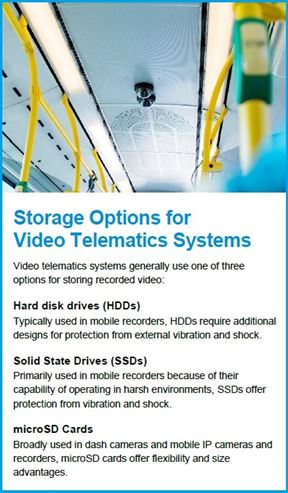 valued at $4.5B in 2019, it is expected to reach $15.8B by 2026 (CAGR of 20%) (*1).
valued at $4.5B in 2019, it is expected to reach $15.8B by 2026 (CAGR of 20%) (*1).
The implementation of video telematics systems in fleet vehicles will result in huge volumes of data. This will require system optimization among data storage, data processing and communication from an end-to-end topology perspective—driving the next innovation in video telematics solutions.
Types of VT Systems
Video telematics systems generally fall into two categories:
- Cameras with onboard storage mounted in the vehicle
- Cameras connected to a mobile recorder mounted in the vehicle
In both scenarios, cameras cover the view of the driver, passengers and outside conditions and monitor for road safety and driver behavior. In addition to video monitoring, these solutions are integrated with GPS tracking and other vehicle-related monitoring, such as fuel, speed, temperature, etc.
With system connectivity improvements, it is possible to transmit data to a centralized management system for real-time monitoring/management. However, for cost efficiency and connection reliability reasons, surveillance video archives are typically stored in a local storage device, like a mobile recorder.
With the growing volumes of data generated by these systems, a robust storage solution is critical for successful operation of video telematics.
This brief describes video telematics systems and discusses how to select a suitable storage solution for your system.
Storage Requirements
Determining Suitable Storage Options for Video Telematics Systems
To determine the most suitable storage options for a video telematics system, four key factors should be considered:
- Ability to Operate in a Harsh Environment
Because the system is in a vehicle, the storage solution must be resistant to vibration and shock while also supporting a wide temperature range. - Footprint (Size)
Mobile design aesthetics are trending to smaller, less obvious form factors; therefore, the size of the storage footprint is an important consideration (Figure 1).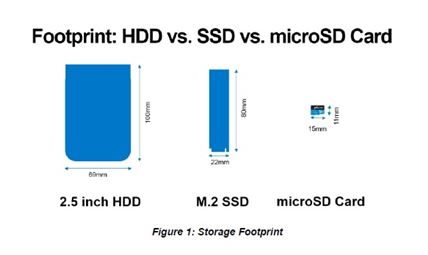
- Storage Retention
In general, a seven-day storage retention period covers most video telematics application usage models in the transportation sector. (See Figure 2 for the range of storage size requirements depending on camera resolution and number of channels needed in the mobile video surveillance system.)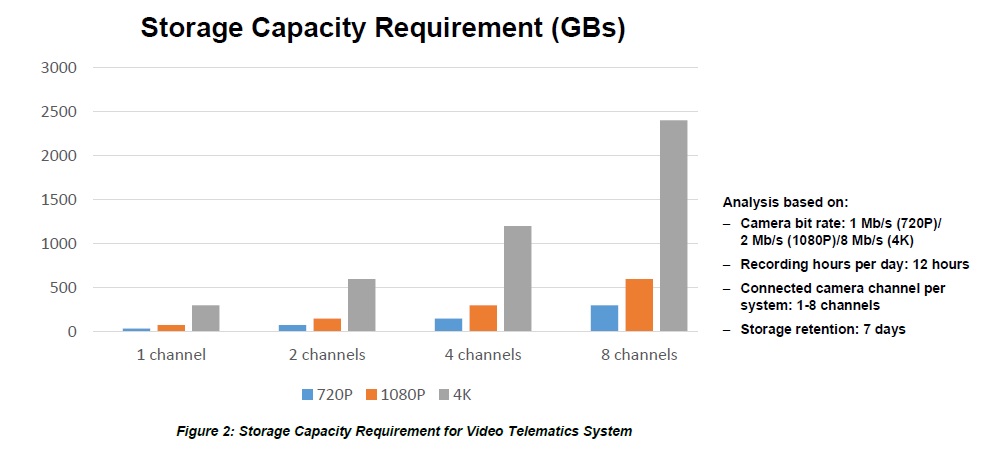
- Upgradability
Removable storage with ease of installation is ideal for storage upgrade requirements in the field. Increasing days of retention, upgrading camera resolution requirements, or adding additional cameras in a vehicle are all scenarios that are easily serviced by simply opening the camera/recorder slot and replacing the storage device with the appropriate density.
Design Considerations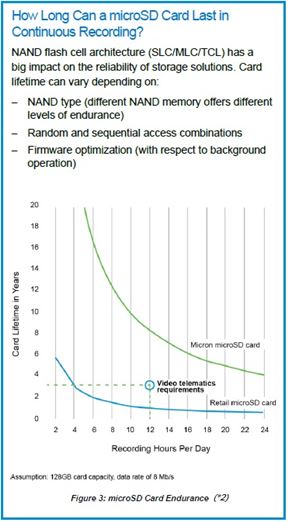
Using microSD Cards as Primary Storage
Given the storage requirements discussed, solid state storage with industrial, ruggedized design and up to 1TB capacity can address most use cases. Industry advancements in NAND technology have enabled high-density solutions in the microSD card form factor, enabling smaller footprint and removability features that provide additional system design benefits. As the microSD card becomes the mainstream primary storage in video telematics systems, designers, installers, and end users must be aware that not all microSD products are the same.
Key considerations with using microSD cards in video telematics systems include:
1. Endurance and Quality, Lower Total Cost of Ownership (TCO)
Is the microSD card designed to handle three years of continuous recording? A typical video telematics system needs to be ruggedized toward all-weather resistance. To reduce maintenance and decommission costs during service years and to lower TCO, a high-endurance, optimized microSD card is essential.
2. Recording Performance Optimization (Lower Risk of Data Loss)
Does the solution give confidence that the microSD card is capturing all essential and critical footage at all times? Continuous video recording into a microSD card can cause frame drop issues. The microSD card must optimize its recording performance for continuous video recording usage to reduce the risk of data loss.
Expected Recording Performance
Sustained recording with minimum/no lost frames is a key focus for video recording.
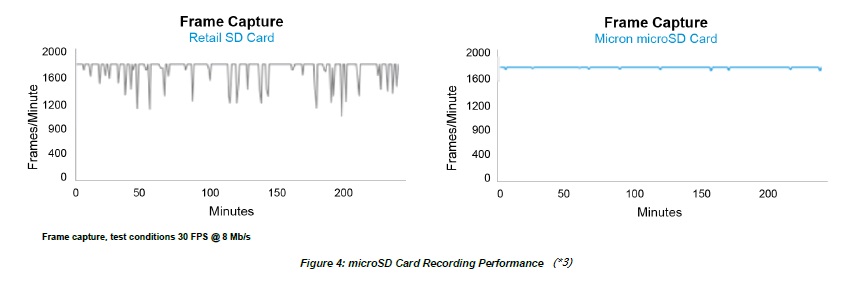

Micron’s Industrial microSD Card for Video Telematics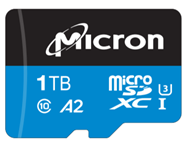
Micron’s industrial microSD cards are specifically designed for edge storage workloads and features:
- Storage densities of 32GB, 64GB, 128GB, 256GB, 512GB and 1TB enable more video to be stored at the edge and increase design flexibility
- Three years of high-quality, continuous, 24x7 video recording in a wide range of temperatures and environments
- A two million hours mean-time-to-failure (MTTF) or 0.44 percent annualized failure rate (AFR)
- Special firmware designed for continuous video recording that minimizes frame drops
- Technology for the cards to self-monitor and provide information on usage and expected useful life remaining
References:
(*1) Global Market Insights – Fleet Management Market Report 2026 Forecast
(*2) (Refer to Figure 3) Based on modeling of vendor’s published specifications
(*3) (Refer to Figure 4) Based on testing with a commercially available camera utilizing a variety of retail cards and Micron’s industrial card; data may vary with different cameras
About Micron
We are an industry leader in innovative memory and storage solutions transforming how the world uses information to enrich life for all. With a relentless focus on our customers, technology leadership, and manufacturing and operational excellence, Micron delivers a rich portfolio of high-performance DRAM, NAND and NOR memory and storage products through our Micron® and Crucial® brands. Every day, the innovations that our people create fuel the data economy, enabling advances in artificial intelligence and 5G applications that unleash opportunities — from the data center to the intelligent edge and across the client and mobile user experience. To learn more about Micron Technology, Inc. (Nasdaq: MU), visit micron.com.
















